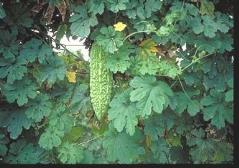
Momordica charantia / القرع المُر
Bitter gourd, Karilla fruit, Balsam pear, Karolla, Bitter Melon
Khyar Karilla
Background
- Bitter gourd is an herbaceous climber of the gourd family (Cucurbitaceae).
- Widespread in the tropical and subtropical regions of the world. Native to India, Bangladesh and cultivated in many countries.
- It has also been used traditionally for the treatment of diabetes.
Part(s) Used
Fruits, seeds, leaves and roots
Traditional and Medicinal Uses
Bitter gourd is an important food plant in some parts of the tropics. It is traditionally used in many countries e.g. South America, Caribbean, Australia, Africa, Asia especially in India and China as a vegetable, sometimes as an ingredient in curries. It has been used as/for:
|
Antidiabetic |
Laxative |
Febrifuge |
Anti-inflammatory |
|
Anthelmintic |
Carminative |
Digestive |
Anti-malaria |
How Much Do We Know?
Bitter gourd has a long history of being used traditionally in many countries for the treatment of diabetes. However, the available research evidence is not quite enough to support this claim.
What Do We Know About Safety?
- Possibly safe when the fruit is used orally and appropriately for short-term on amounts usually used in food.
- There is insufficient reliable information available about the safety of long-term use.
- There is insufficient reliable information available on the safety of topical use.
Using Bitter gourd by
Mouth
Bitter gourd fruit has been used in doses of 0.5-12 grams daily for up to 16 weeks.
Special Precautions & Warnings
Pregnancy
Possibly unsafe when used orally. Animal studies shows that some Bitter gourd’s constituents possess abortifacient properties, and reduces the fertility rate.
Breast feeding
Insufficient reliable information available; avoid using.
Keep in Mind
- Do not hesitate to speak with your health care provider before starting to use any supplements.
- Discuss potential benefits and risks, especially if you are suffering from any health problems.
